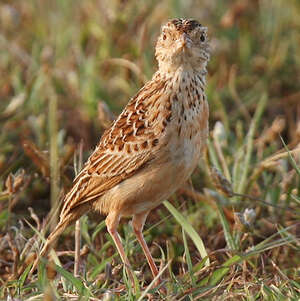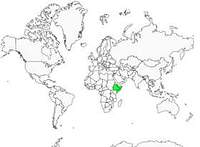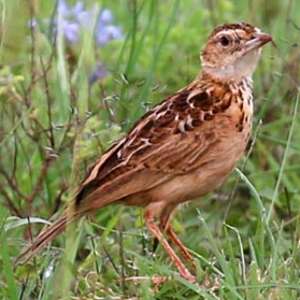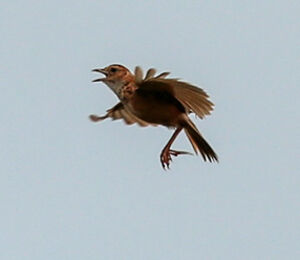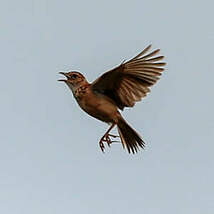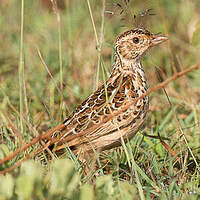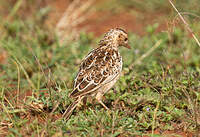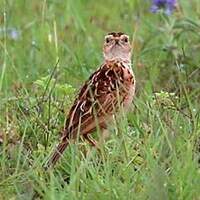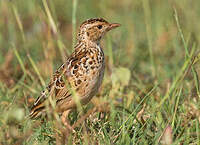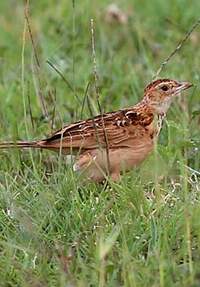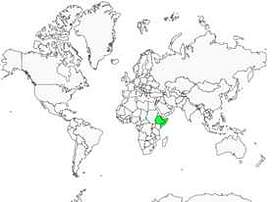Archer's Lark
Heteromirafra archeri - Alouette d'Archer
Identification
Archer's Lark has a distinct silhouette. Quite compact, it shows a quite massive head, relatively short wings and tail. The upper parts are tricoloured (black, fawn and white). The darkest parts are the cap and mantle; black being the dominant colour. The scapulars and tertials, black and fawn, are edged in black and white, giving a scaly appearance. The wings are more uniformly brown. The neck, which appears thin compared to the head, is clearly more grey and finely streaked. The head is wide. In profile, the dark brown eye stands out well as the lore and cheek are light. In addition, it is surmounted by a wide cream eyebrow. Viewed from the front, the head appears chubby, with the fawn parotids standing out. The black cap has a clearly visible light median stripe. Viewed from the back, the cap shows finer stripes (up to 10 on a photo), alternately black and fawn, on either side of the median stripe. The bill, fairly short and thick, shows a straight undersurface and a curved culmen. It appears bicoloured on the ground, horn or even slightly blue at the base and dark at the tip. The tail is fairly warm brown, the outer rectrices being cream and visible when spread in flight. The underparts are clearly rufous. The chest is lighter and speckled with small blackish streaks. The throat is white. The legs are pinkish, with a rather long tarsus, and they have a very long back claw.
The sexes are identical. The juvenile is barely different. Its plumage is generally less dark and slightly less contrasted. The upper feathers are more widely edged with cream giving a typical scaly appearance. The beak is pinkish. Two subspecies are described, archeri and sidamoensis, which differ only in plumage and size details.On the ground, Archer's Lark could be confused with the Rufous Lark (A. somalica) which cohabits with it and is also heavily streaked above and rufous below. However, the latter is slightly smaller, is seen less frequently and is often seen in flocks. Its streaked crown has no clear median stripe, the bill is weaker, the face is not entirely pale and above all, the upper plumage is two-toned and appears non-scaly.
Subspecific information monotypic species
Foreign names
- Alouette d'Archer,
- Alondra de Archer,
- cotovia-de-liben,
- Somalispornlerche,
- szomáli pacsirta,
- Somalische Sporenleeuwerik,
- Allodola di Archer,
- archerlärka,
- Slettelerke,
- škovránok somálsky,
- skřivan západosomálský,
- Somalilærke,
- somalianruohikkokiuru,
- alosa d'Archer,
- pazurczak samotny,
- Жаворонок Арчера,
- ソマリアニセヤブヒバリ,
- 阿氏歌百灵,
- libenlärka,
- 阿契氏歌百靈,
Voice song and call
Its call is a rolling sree that may be repeated. It has the high-pitched tone of a song. The alarm call is a succession of whistled notes tu tu tu tu tu.... The song is similar to that of the Meadow Lark, but weaker and less varied, yet it has the same tone. It is also uttered in flight.
Habitat
Behaviour character trait
The Archer's Lark is a rare species in its habitat. Furthermore, it seems to not form groups outside of the breeding season. Finally, it is incredibly discreet. Disturbed, rather than flying away, it prefers to slip away by slinking its back lowered between the grasses as a small quail. In the open, it runs quickly toward herbaceous cover. To hope to observe this species, one must be patient. Once a territory has been located, it is best to not move and let it show itself once the initial apprehension has passed. Then it is possible to see it stand tall and hold its head high, inspecting the surroundings.
Flight
Dietfeeding habits
Reproduction nesting
We have very little information about this. The species is monogamous. Reproduction takes place in June. The display is unknown. The nest, made of woven vegetable fibers, is built under a tuft of grass which covers it. Laying consists of 3 eggs. Parental behaviour, incubation and raising the young remain to be studied.
Geographic range
Archer's Lark is an endemic species of the Horn of Africa. The archeri subspecies frequents the Wajale Plateau in northwestern Somaliland and the adjacent Jijiga Plateau in Ethiopia. It has not been recently found in Somalia.
The sidamoensis subspecies, originally treated as a full species, Erard's Heteromirafra sidamoensis, frequents the Liben Plain near Negele in southern Ethiopia. Its status there is precarious.
Likely resident.
Threats - protection
IUCN conservation status
concern
in the Wild
threatened
evaluated
The species is classified as Critically Endangered. Its status is uncertain in Somalia. The species has apparently disappeared from its type locality due to habitat degradation. It is thought that in Ethiopia, the populations of the Liben and Jijiga plains are in rapid decline. They are estimated at a little less than 250 adult individuals.
The grassland habitat is severely affected by agricultural practices and above all overgrazing and human pressure.
At present, the species does not benefit from any protected areas or any protection measures.
If we want to save it, it is essential to create protected areas, restore its habitat and work with local populations to establish a pasture exploitation that is favourable to its survival.
Small hope however. As it is a species that goes unnoticed, it is possible that it is more widespread than the few known data suggest.
Sources of information
- IOC World Bird List (v15.1), Gill, F and D Donsker (Eds). 2025-12-07.
- HBW Alive,
- IUCN Red List of Threatened species,
- Avibase, Lepage Denis
- xeno-canto, Sharing bird sounds from around the world,
- Birds of the Horn of Africa, Nigel Redman
Other sources of interest
 Specification sheet created on
28/10/2023 by Patrick Derennes
Specification sheet created on
28/10/2023 by Patrick Derennes partially rewritten on 00/00/0000 by Jean François
Translation by AI Oiseaux.net
© 1996-2025 Oiseaux.net
- Accipitriformes
- Aegotheliformes
- Anseriformes
- Apodiformes
- Apterygiformes
- Bucerotiformes
- Caprimulgiformes
- Cariamiformes
- Casuariiformes
- Charadriiformes
- Ciconiiformes
- Coliiformes
- Columbiformes
- Coraciiformes
- Cuculiformes
- Eurypygiformes
- Falconiformes
- Galliformes
- Gaviiformes
- Gruiformes
- Leptosomiformes
- Mesitornithiformes
- Musophagiformes
- Nyctibiiformes
- Opisthocomiformes
- Otidiformes
- Passeriformes
- Pelecaniformes
- Phaethontiformes
- Phoenicopteriformes
- Piciformes
- Podargiformes
- Podicipediformes
- Procellariiformes
- Psittaciformes
- Pterocliformes
- Rheiformes
- Sphenisciformes
- Steatornithiformes
- Strigiformes
- Struthioniformes
- Suliformes
- Tinamiformes
- Trogoniformes

